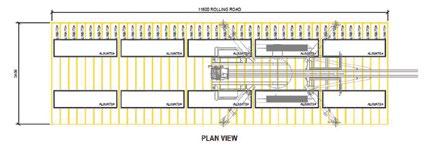
3 minute read
Spider lift mats spike
Case Study
Spider lift mats spike
Brilliant Ideas has seen a surprising 500 percent spike in demand for its Alimats load spreading solutions for spider lifts in recent months. Managing director Dan Westgate says: "In our experience most spider lifts are used on newly constructed suspended floors, so a lot of our enquiries are for load spread solutions for both the tracking and operating condition. The key difference between tracked and wheeled machines is that the tracks apply the load along their length, covering a larger area compared to wheels, so load spread solutions when moving are a little simpler."
"However, we also receive enquiries where it’s proposed to spread the load with sheets of plywood, that simply doesn’t work. We’ve seen multiple cases where such proposals have been rejected by the client’s temporary works. Plywood is simply not stiff enough to spread the load, and therefore won’t reduce the pressure applied to the supporting floor below."
Brilliant Ideas has helped with numerous tracking projects such as University College London where its interlocking Alimats system was used by concrete cladding contractor Techrete to provide a solution to track a spider lift from the landing zone all the way to the operating area. It used 40, 3.48 metre x 290mm, interlocking modules laid on top of an Ethafoam base layer. The second layer used 26, 2.18 metre x 580mm mats laid end to end and placed perpendicular to the first layer to create a path for the machine’s tracks. When the spider set its outriggers, the first layer mats were wide enough to support the machine.

Another project involved a large spider lift on a site in Woolwich, London. Although much shorter, the tracking solution was identical to that used at University College London, however when the outriggers were set, the load under each foot had to be spread over the entire mat area. To achieve this each outrigger needed an Ethafoam base layer, topped by eight 3.48 metre x 290mm interlocking modules, four 2.18 metre x 580mm modules placed perpendicular, then a top layer of two 2.18 metre x 580mm units placed parallel to the first layer with a 50mm thick, one metre diameter Nylacast outrigger mat under the outrigger feet.

“We find that even a single layer of our interlocking system can seamlessly spread the load when tracking,” says Westgate. “Due to their length and the machine’s tracks being in contact with multiple mat modules at any given time as it tracks across. Our extra-long narrow modules - 3.48 metres x 290mm - come into their own in these scenarios.”
“In a rolling road scenario, we often use our core Alimats outrigger mats, so that surplus mats from the rolling road can be used as regular outrigger mats, reducing the number of mats on a project saving on transport and hire.”







